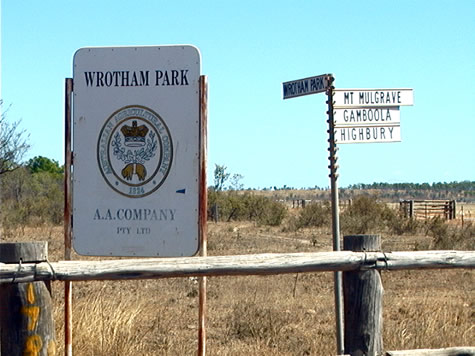Near the end of our 60 km ride today we visited Wrotham Park, a cattle station here in this remote section of Queensland. Read some of the other updates today and find out how big this station is. It is HUGE.

What I’ll talk about here is the schooling of the children on the station. We met Sam, the 13 year-old son of the station manager. Sam and his brothers and sisters have been educated through a ‘Distance Learning’ program based in Cairns, as are many outback children. The lessons are done with a member of the family here on the station with frequent UHF radio contact, as well as phone conversations with his teacher over in Cairns on the other side of the Great Dividing Range.
To support the Distance Learning program there’s also the ‘Volunteers for Isolated Students Education’ (VISE), whereby retired teachers work in rotation for six-week stints at stations. I met John Swanson, who has worked for 8 years as a teacher for three months a year at two different stations per year. He’s worked with Sam’s older brothers and sisters in past years, and in our conversation today he said he’s focusing on Sam’s mathematics this year.
Here’s an interesting use of technology. For Sam’s music studies he’s chosen the trombone. He makes a phone connection once a week with his trombone teacher and the teacher listens to Sam’s playing, makes corrections and suggestions, plays some sample music, and Sam continues his daily practice until the following week. Does it work? Once a term all the Distance Learning students meet in Cairns for a week. All the kids with their instruments gather and form a band. They practice for a little while, and then perform. And they win competitions, too! They’re reputed to be very good.
Most of Sam’s communications are via the UHF radio, which is the cheapest method of communication. Every morning Sam phones into his teacher at 9:00 a.m. Or, they can radio into a location in the morning, to a message center, and then make the necessary phone calls, which have become a bit cheaper recently from station-to-station, but are still costly into Cairns.
The daily conversations are about a half-hour in length, and Sam can phone back during the day with other questions he might have. He spends a few hours a day on his lessons.
You might be asking, ‘what about the Internet? Video conferencing? Chat sessions? Web-based research? Well, out here it’s all about speed. Most phone lines are still very slow for internet connections and it takes too long for information to come down-line. Telstra, the Australian phone company, is working to provide better access.
Every two weeks Sam sends in a completed unit by mail, which is corrected by his teacher.
So it’s a real combination of technologies at use in Sam’s schooling: phone, radio, a bit of computer and internet, paper and pencil, parent tutoring, and six weeks of support from a visiting teacher.
How does this compare to your schooling? Do you think you’d like it?
Jim